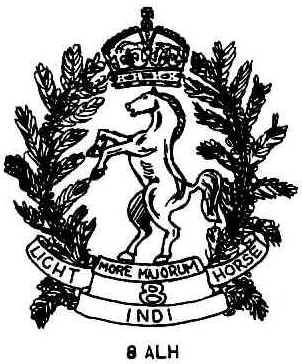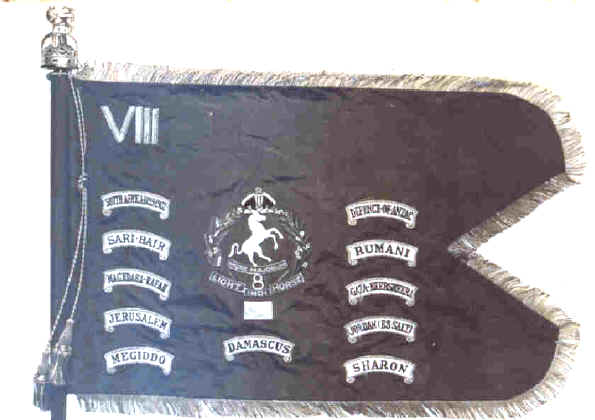 |
| Category:
Lt Horse Regiments |

|
|
|
|
|

8th
Light Horse Regiment (Victoria)
[3rd
Light Horse Brigade]
Served in Egypt, Gallipoli, Sinai, Palestine
Formed Victoria October 1914 for 3rd Light Horse Brigade.
Badge displayed either
unofficial or CMF. |
 |
- Departed Melbourne on
Star
of Victoria 25 February 1915.
- 1st Reinforcements departed Melbourne on
Runic
25 February 1915,
- 2nd Reinforcements departed Melbourne on Armadale
12 February 1915,
- 3rd Reinforcements departed Melbourne on Pera
8 February 1915,
- 4th Reinforcements departed Melbourne on Wiltshire
13 April 1915,
- 5th Reinforcements departed Melbourne on Palermo
7 May 1915,
- 6th Reinforcements departed Sydney on Uganda
22 June 1915,
- 7th Reinforcements departed Melbourne on Malakuta
23 September 1915,
- 8th Reinforcements departed Melbourne on Kyarra
20 August 1915,
- 9th Reinforcements departed Melbourne on Hororata
27 September 1915,
- 10th Reinforcements departed Melbourne on Ballarat
9 September 1915,
- 11th Reinforcements departed Melbourne on Hawkes
Bay 28 October 1915
- 12th Reinforcements departed Melbourne on
Hawkes
Bay 28 October 1915
- 13th Reinforcements departed Sydney on Vestalia
18 January 1916,
- 14th Reinforcements departed Melbourne on Hymettus
27 January 1916,
- 15th Reinforcements departed Melbourne on Barunga
7 April 1916,
- 16th Reinforcements departed Melbourne on Uganda
2 Mayl 1916,
- 17th Reinforcements departed Melbourne on Clan
MacCorquodale 6 May 1916,
- 18th Reinforcements departed Melbourne on
Mongolia
11 Ju1y 1916,
- 19th Reinforcements departed Melbourne on Mongolia
11 Ju1y 1916,
- 20th Reinforcements departed Melbourne on Hymettus
12 September 1916,
- 21st Reinforcements departed Melbourne on Hymettus
12 September 1916,
- 22nd Reinforcements departed Melbourne on Clan
MacCorquodale 19 September 1916,
- 23rd Reinforcements departed Melbourne on
Anglo-Egyptian
31 January 1917,
- 24th Reinforcements departed Melbourne on Anglo-Egyptian
31 January 1917,
- 25th Reinforcements departed Melbourne on Karmala
6 February 1917,
- 26th Reinforcements departed Melbourne on Morea
11 May 1917,
- 27th Reinforcements departed Melbourne on Boorara
10 May 1917,
- 28th Reinforcements departed Melbourne on Port
Lincoln 22 June 1917
- 29th Reinforcements departed Kyarra
7 September 1917,
- 30th Reinforcements departed Melbourne on Commonwealth
2 November 1917,
- 31st Reinforcements departed Sydney on Wiltshire
2 February 1918
Battle Honours:
- Anzac,
- Defence of Anzac,
- Suvla,
- Sari
Bair,
- Gallipoli 1915,
- Romani,
- Maghdaba-Rafah,
- Egypt 1915-17,
-
Gaza-Beersheba,
|
- El Mughar,
- Nebi Samwil,
- Jerusalem,
- Jordan (Es Salt),
-
Megiddo,
- Sharon,
- Damascus,
- Palestine 1917-1
|
|
 |
| The Guidon
of the 8th Light Horse |
Leslie Fraser Standish Hore MC
1870-1935)
Leslie Fraser Standish 'George' Hore
was born on 5 August 1870 in Murree in India. He was educated in
England at Wellington College and Corpus Christi College, Oxford
University. He worked as a solicitor and barrister in London and
Hobart before joining the AIF (Australian Imperial Force) in 1914. His
wife, Emily Josephine, remained in Hobart. On 25 February 1915, Hore
left Australia as a captain with the 4th reinforcements for the 8th
Australian Light Horse Regiment. He joined the regiment at Gallipoli
on 26 May and was wounded at the Battle of the Nek on 7 August.
Writing to his mother from the
hospital ship he described the destruction of the 8th Light Horse:
Truly we have been through the valley
of the shadow of death as our Regiment has been cut to pieces and
all our officers killed or wounded except two, out of eighteen
officers present twelve were killed and four wounded... Our Colonel
was killed, one Major killed the other wounded, the only Captain
(myself) wounded and ten subalterns killed and three wounded leaving
two officers not hit, killed or wounded, and about five percent of
the men. And so perished the 8th Light Horse.
[LSF Hore, letter, in Cameron
Simpson, Maygar's Boys: A biographical history of the 8th Light
Horse Regiment AIF 1914-19, p.281]
At the Nek, Hore received a bullet
wound through the bone of his right foot and another through his right
shoulder: 'the latter only an inconvenience and the former a clean
hole which ought to heal in about six weeks.' He rejoined his unit on
28 September.
While he was at Gallipoli, Hore
sketched the men, the animals, the trenches and the terrain,
documenting life at Anzac between June and December. Not surprisingly,
a number of his sketches feature Indian soldiers.
Preferring to fight in France rather
than stay with the Light Horse regiments in the Middle East, Hore
accepted an offer on trial as Brigade Machine Gun Officer of the 6th
Infantry Brigade. In March 1916 he travelled with the Brigade to
France:
His knowledge of M.G.'s was summed up
in three letters-nil, and at the time of his transfer he did not
know a soul or a soldier in the brigade. But by the time the command
of the 6th M.G. Coy. became vacant at Fleurbaix, it was obvious that
Hore was the man to make individuals into a unit.
[Major-General Sir John Gellibrand,
quoted in Hore's obituary, Reveille, November 1935]
Hore was promoted to Major at
Pozieres in France and then to Lieutenant Colonel. On 18 June 1916, he
was awarded the Military Cross (MC) for conspicuous gallantry at
Pozieres. Later that year he was posted to the Machine Gun Training
Depot at Grantham in England. From January 1917 until March 1918, he
was Corps Machine Gun Officer for 1 Anzac (Corps) before returning to
the 2nd Machine Gun Battalion. On 7 November 1917, Hore was mentioned
in dispatches by Sir Douglas Haig. In February 1919, Lieutenant
Colonel Hore left England for Australia in the Orca.
Shortly after his return he went to
Rabaul, New Britain, as a Law Officer with the Naval and Military
Expeditionary Force: he transferred to the civil administration when
the military occupation came to an end.
Hore later resigned to take up a
plantation in the Kavieng district on New Ireland where he remained
until his death on 1 September 1935. He was buried in Kavieng cemetery
with full military honours and six war veterans carried his casket to
the grave.
In an obituary in Reveille, in
November 1935, Major-General Sir John Gellibrand wrote:
To those who served with him he
stands as an example of the Good Comrade. It was a pleasure to be
with him, a comfort to work with him and now it is an abiding sorrow
that his days have been numbered.
[Major-General Sir John Gellibrand,
quoted in Hore's obituary, Reveille, November 1935]
Sources
-
CEW Bean, The Story of Anzac,
Vol II, The Official History of Australia in the War of 1914-1918,
Sydney, 1924.
-
Official History, 1914-18 War:
Records of Charles E W Bean, Official Historian: Biographies and
other research files: Hoping, JL-Horne, CD. A391, AWM 43,
Australian War Memorial.
-
LSF Hore, First World War
Dossier, B2455/1, National Archives of Australia.
-
Cameron Simpson, Maygar's Boys:
A Biographical History of the 8th Light Horse Regiment AIF
1914-19, Moorooduc, 1998
Carolyn Newman
many details on this page from Ross
Mallett's site
balance of above is from http://www.dva.gov.au/media/publicat/2001/northbeach/page_99.htm
|
8th Light Horse Regiment
The regiment that would eventually
become the 8th Light Horse Regiment was formed at Broadmeadows camp in
Victoria on 23 September 1914 as the 6th Light Horse Regiment. A
reorganisation of the rapidly expanding AIF in early October resulted in
the 6th being renumbered the 8th, and it became part of the 3rd Light
Horse Brigade. It sailed from Melbourne on 24 February 1914 and arrived
in Egypt on 14 March 1915.
The light horse were considered
unsuitable for the initial operations at Gallipoli, but were
subsequently deployed without their horses. The 3rd Light Horse Brigade
landed in late May 1915 and was attached to the New Zealand and
Australian Division. The 8th formed the first two waves for the
Brigade’s disastrous attack on the Nek on 7 August and suffered
heavily. Exhausted and under-strength, the regiment then played a
defensive role until it finally left the peninsula on 20 December 1915.
Back in Egypt, the 3rd Light Horse
Brigade became part of the ANZAC Mounted Division and, in March 1916,
joined the forces defending the Suez Canal from a Turkish drive across
the Sinai Desert. The Turks were turned at Romani. Although it didn’t
take part in the actual battle, the 8th Light Horse participated in the
advance that followed the Turks’ retreat back across the desert.
By December 1916, this advance had
reached the Palestine frontier and the 8th was involved in the fighting
to secure the Turkish outpost of Maghdaba on 23 December, which was
captured at bayonet point. The next Turkish stronghold to be encountered
was Gaza. The 3rd Light Horse Brigade, now part of the Imperial Mounted
Division (later re-named the Australian Mounted Division), was involved
in the two abortive battles to capture Gaza directly (27 March and 19
April 1917) and then the operation that ultimately led to its fall –
the wide outflanking move via Beersheba that began on 31 October.
With the fall of Gaza on 7 November
1917, the Turkish position in southern Palestine collapsed. The 8th
participated in the pursuit that followed and led to the capture of
Jerusalem in December. The focus of British operations then moved to the
Jordan Valley. In early May 1918 the 8th was involved in the Es Salt
raid. It was a tactical failure but did help to convince the Turks that
the next offensive would be launched across the Jordan.
Instead, the offensive was launched
along the coast on 19 September 1918. The mounted forces penetrated deep
into the Turkish rear areas severing roads, railways and communications
links. The 8th Light Horse took part in the capture of Tiberius on 25
September and Sasa on 29 September. It entered Damascus on 1 October,
and was resting in Homs when the Turks surrendered on 31 October. While
waiting to embark for home, the regiment was called back to operational
duty to quell the Egyptian revolt that erupted in March 1919; order was
restored in little over a month. The 8th sailed for home on 3 July 1919.
This text from AWM
- 302 killed, 675 wounded
-
Decorations
- 3 DSO
- 8 MC
- 10 DCM
- 13 MM
- 36 MID
- 3 foreign awards
|
|